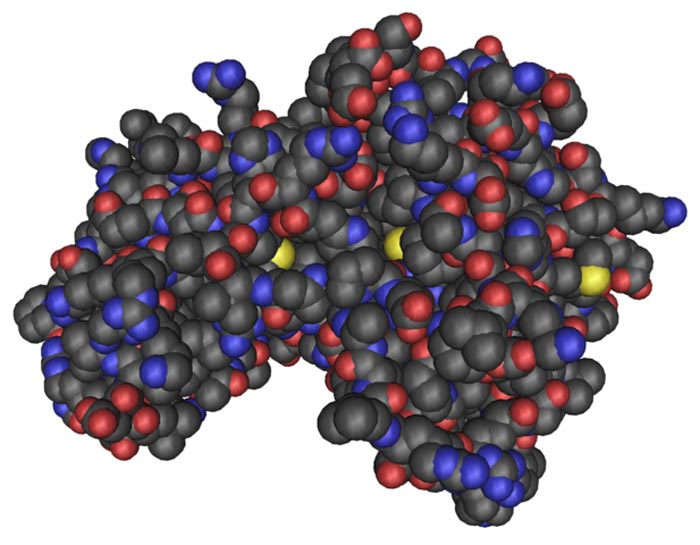

Molecule model of AMP-activated protein kinase. Source: Nevit Dilmen / Wikipedia / Licence CC BY SA 3.0
Cancer often results in weight loss due to unwanted metabolic complications. This so-called cancer cachexia is accompanied by a poor prognosis with regard to disease progression, quality of life, and mortality. After sepsis, cachexia is the most frequent cause of death in cancer patients. It is not entirely clear which biochemical mechanisms play a role. To date there have also not been any pharmacological possibilities for selectively influencing tumor-associated wasting syndrome.
Stopping energy wasting molecularly
Researchers at the Institute for Diabetes and Cancer (IDC) at Helmholtz Zentrum München have identified the AMP-activated protein kinase (AMPK) as the central enzyme in cancer cachexia. AMPK is normally responsible for protecting cells from energy deficiency. In the case of cancer cachexia, however, AMPK activity is inhibited due to the illness, resulting in a pointless waste of the body's own energy store.
Selective AMPK reactivation was successfully carried out in tumor models. The therapeutic manipulation took place through a specific peptide which prevents the interaction between AMPK and the lipid droplet-associated protein Cidea, and which consequently can stop the increased fat breakdown (lipolysis) found in tumor diseases.
“Our data suggest that the preservation of “healthy” adipose tissue can promote not only the quality of life, but also the response to treatment and the survival of cancer patients,” says Prof. Stephan Herzig, IDC Director. “The interaction between AMPK and Cidea can be taken as a starting point for developing new lipolysis inhibitors which could then prevent the breakdown of energy stores in the fat of tumor patients.” He furthermore sees possibilities for transferring the acquired insights to other wasting disorders, such as with sepsis or burn injuries.
Further information
Original publication: Maria Rohm et al. (2016), An AMPK-stabilizing peptide ameliorates adipose tissue wasting in cancer cachexia in mice. Nature Medicine, doi:10.1038/nm.4171. Abstract: http://www.nature.com/nm/journal/vaop/ncurrent/full/nm.4171.html
The Helmholtz Zentrum München, as the German Research Center for Environmental Health, pursues the objective of developing personalized medicine for the diagnosis, therapy and prevention of wide-spread diseases such as diabetes mellitus and lung diseases. To this end, it investigates the interactions of genetics, environmental factors and lifestyle. The Zentrum's headquarters is located in Neuherberg in the north of Munich. The Helmholtz Zentrum München employs around 2,300 people and is a member of the Helmholtz Association, which has 18 scientific-technical and biological-medical research centers with around 37,000 employees.
www.helmholtz-muenchen.de
The Institute for Diabetes and Cancer (IDC) is a member of the Helmholtz Diabetes Center (HDC) at the Helmholtz Zentrum München and a partner in the joint Heidelberg-IDC Translational Diabetes Program. The Institute for Diabetes and Cancer is tightly integrated into the German Center for Diabetes Research (DZD) and into the special research area “Reactive Metabolites and Diabetic Complications” at the Heidelberg University Medical School. The IDC conducts research on the molecular basis of severe metabolic disorders, including metabolic syndrome and type 2 diabetes, as well as their roles in tumor initiation and progression. https://www.helmholtz-muenchen.de/idc












